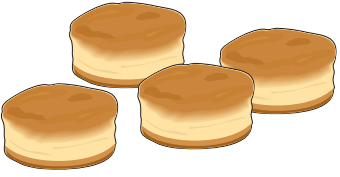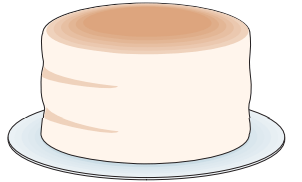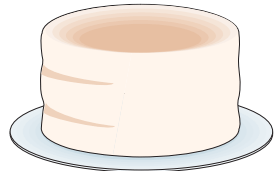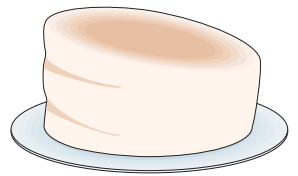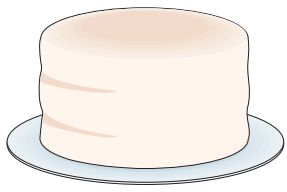Documents: Go to download!
User Manual
- User Manual - (English)
- Quick Start Guide - (English)
- Installation Instructions - (English)
- Product Specifications Sheet - (English)
- SETTING OVEN CONTROLS
- CARE & CLEANING
- TROUBLESHOOTING
Table of contents
Freestanding Gas Range User Manual
SETTING OVEN CONTROLS
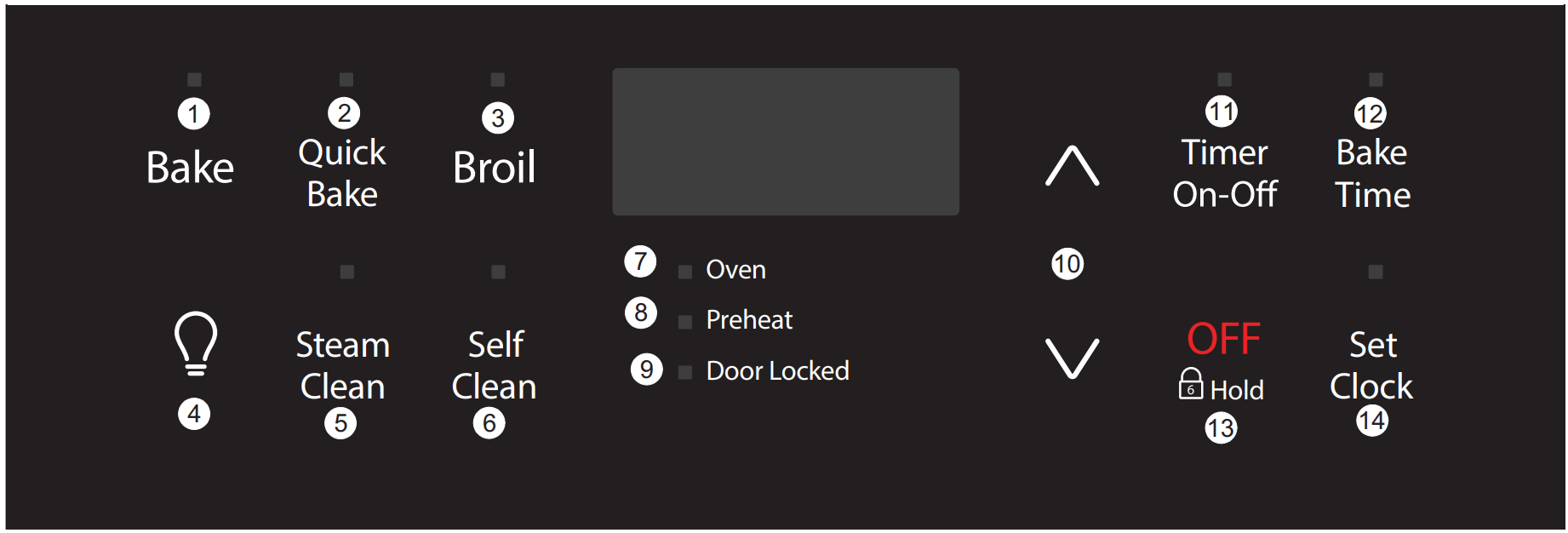
Oven Control Features
- Bake - Use to select bake feature.
- Quick Bake - Quick Bake uses a fan to circulate the oven's heat uniformly and continuously around the oven.
- Broil - Use to set Broil feature.
- Oven Light - Use to turn on internal light when checking on food. Also will turn on when the oven door is open.
- Steam Clean - The Steam Clean feature offers a time saving method for cleaning of small and light soils.
- Self Clean - Use to with arrow keys to set self clean cycle of 2 or 3 hours.
- Oven on indicator light - The oven light will glow each time the oven turns on to maintain the set oven temperature.
- Preheat light - The preheat light will glow when the oven is preheating or if the desired temperature is reset higher than the actual oven temperature.
- Door locked - The door locked light will flash when the oven door locks and unlocks, when the oven door lockout is active, or when the self clean cycle feature is active.
- Up and Down arrows - Use with the feature or function keys to set oven temperature, bake time, start time, clean time, and setting or adjusting the clock and minute timer.
- Timer on-off - Use to set or cancel the minute timer. The minute timer does not start or stop any cooking function. Timer on-off is used to set the continuous bake function.
- Bake Time - Enters the length of baking time desired.
- OFF - Use to clear any feature except the time of day and minute timer and to activate oven lockout feature.
- Set Clock - Use with arrow keys to set the time of day
Table 2: Minimum and maximum control settings
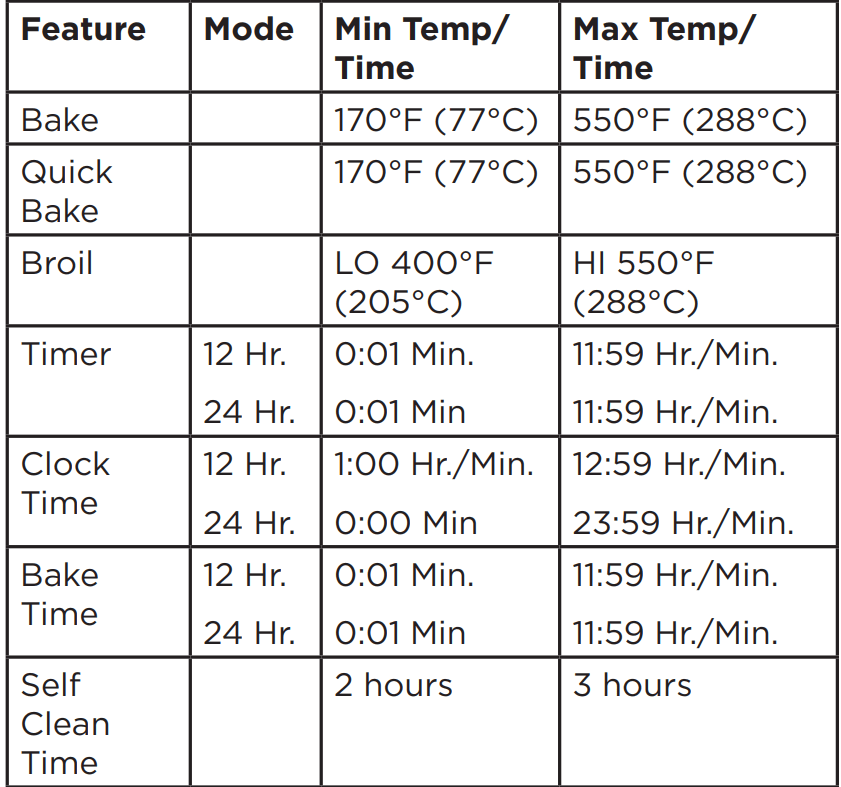
Note: An entry acceptance tone (1beep) will sound each time a key is touched (the oven lock key is delayed 3 seconds). An entry error tone (3 short beeps) will sound if the entry of the temperature or time is below the minimum or above the maximum settings for the feature.
Setting the Clock
When the appliance is first plugged in or when the power supply to the appliance has been interrupted, the display will flash 12:00. It is recommended to always set the clock for the correct time of day before using the appliance.
To set the clock:
- Press Set Clock once (do not hold clock key down).
- Within 5 seconds, press and hold
 or
or  until the correct time of day appears in the display.
until the correct time of day appears in the display.
NOTE The clock cannot be changed when the oven is set for cooking.
Temperature display (Fahrenheit/Celsius)
The electronic oven control is set to operate in Fahrenheit (°F) at the factory. The oven may be programmed for any temperature from 170°F to 550°F (77°C to 288°C).
To change the temperature to Celsius (°C) or from °C to °F:
- Press broil. — — appears in the display
- Press and hold
 until HI appears in the display.
until HI appears in the display. - Press and hold broil until °F or °C appears in the display.
- Press
 or
or  to change °F to °C or °C to °F. To accept the change, wait 6 seconds
to change °F to °C or °C to °F. To accept the change, wait 6 seconds
Changing between continuous bake setting or 12-hour energy saving feature
The oven control has a built-in 12-hour energy saving feature that will shut off the oven if the oven is left on for more than 12 hours. The oven control can be programmed to override this feature for continuous baking.
To change the continuous bake setting:
- Press and hold timer on-off for 6 seconds until a tone sounds. — — hr will appear in the display for continuous cooking. The current time of day will return to the display.
- To cancel the continuous bake setting, press timer on-off and hold for 6 seconds until a tone sounds. 12 hr will appear in display indicating that the control has returned to the 12-hour energy saving feature.
IMPORTANT Changing to continuous bake or 12 hour mode does not change how the cooktop controls operate.
Setting oven lockout
The control can be programmed to lock the oven door and lockout the oven control keypad.
To set the oven lockout feature:
- Press OFF and hold for 3 seconds. Loc will appear in display, the door locked indicator light will flash, and the motor driven door lock will begin to close. Allow about 15 seconds for the oven door to lock. Once the oven door is locked, the current time of day will appear in the display.
- To cancel the Oven Lockout feature, press OFF and hold for 3 seconds. The control will unlock the oven door and resume normal operation.
NOTE If any control key is pressed with the oven lockout feature active, Loc will appear in the display until the control key is released. But it does not disable the clock, kitchen timer, or the interior oven lights.
Setting the minute timer
- Press Timer on-off.
- Press
 to increase time in one-minute increments.
to increase time in one-minute increments.- Press and hold
 to increase time in 10-minute increments. The timer can be set for any amount of time from 1 minute to 11 hours and 59 minutes.
to increase time in 10-minute increments. The timer can be set for any amount of time from 1 minute to 11 hours and 59 minutes.- NOTE If
 is pressed first, the timer will advance to 11 hours and 59 minutes.
is pressed first, the timer will advance to 11 hours and 59 minutes.
- NOTE If
- Press and hold
- When the set time ends, the timer will beep three times and will continue to beep three times every minute until timer on-off is pressed.
NOTE The minute timer will not start or stop the cooking process. The minute timer can be used alone or while using any of the other oven features. If another feature is active when the minute timer is active, the minute timer will show in the display. To view information about other active features, press the key for that feature.
To change the timer while it is in use:
While the timer is active and shows in the display, press and hold  or
or  to increase or decrease the time remaining.
to increase or decrease the time remaining.
To cancel the minute timer before the set time has run out:
1. Press Timer on-off once.
Operating Oven Lights
The interior oven lights will automatically turn on when the oven door is opened. Oven lights will not operate during a self clean cycle.
Press  to turn the interior oven lights on and off whenever the oven door is closed.
to turn the interior oven lights on and off whenever the oven door is closed.
The interior oven lights are located on the rear wall of the oven interior and are covered with a glass shield. The glass shield protects the bulb from high temperatures and should always be in place whenever the oven is in use.
Setting Bake
Bake cooks with heat that rises from the oven bottom. The heat and air circulate naturally in the oven. The oven indicator light above the BAKE key will remain on until oven is preheated. During baking the oven indicator light will turn on and off as the oven cycles to maintain set temperature.
Follow baking recommendations for best results.
The oven can be programmed to bake at any temperature from 170°F to 550°F (77°C to 288°C).
The factory preset automatic bake temperature is 350 °F (177°C).
Baking Tips:
- Fully preheat the oven before baking items like cookies, cakes, biscuits, and breads.
- When baking items like cookies, cakes, biscuits, and breads using a single rack place rack in position 4.
- When using any single rack for items like frozen pies, angel food cake, breads, and casseroles, use rack position 3
- For best results when baking cakes using two oven racks, place racks in positions 3 and 5 (Figure 11)
- When baking using two oven racks, position cookware as shown in Figure 11.
- Allow at least 2 inches (5 cm) of space between cookware for proper air circulation.
- Do not open the oven door often. Doing so will extend baking time
- Leave oven light off while baking.
To set Bake:
- Press Bake. — — — appears in the display.
- Within 5 seconds, press
 or
or  The display will show 350°F (177°C). The temperature can then be adjusted in 5°F (1°C) increments.
The display will show 350°F (177°C). The temperature can then be adjusted in 5°F (1°C) increments. - When a key is released, the oven will begin heating to the selected temperature. When the oven reaches the set temperature, the preheat indicator light will turn off and the control will beep three times.
- To cancel the baking function, press OFF.
To change oven temperature after Bake has started:
- Press Bake.
- Press
 or
or  to increase or decrease to a new temperature. The oven indicator light on the electronic display will turn on and off when using the bake feature and during preheat. This is normal and indicates that the oven is cycling to maintain the selected baking temperature. To cancel baking press OFF.
to increase or decrease to a new temperature. The oven indicator light on the electronic display will turn on and off when using the bake feature and during preheat. This is normal and indicates that the oven is cycling to maintain the selected baking temperature. To cancel baking press OFF.
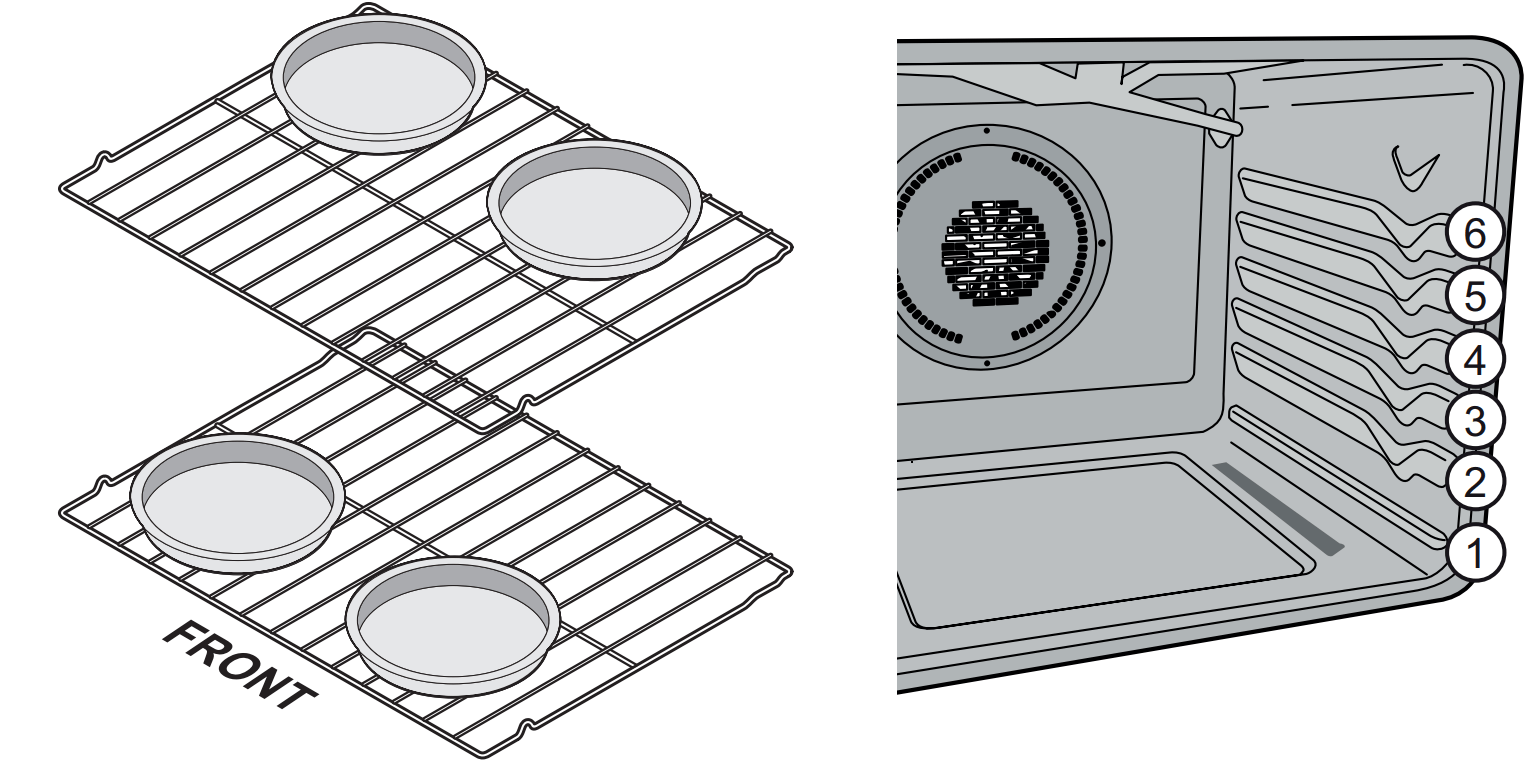
Figure 11: Rack positions; pan positions for two rack baking.
Setting Quick Bake
Quick Bake uses a fan to circulate the oven's heat uniformly and continuously around the oven. This improved heat distribution allows for fast, even cooking and browning results. Meats cooked with
Quick Bake are crisp on the outside while staying tender and moist on the inside. Breads and pastry brown more evenly. Most foods can be cooked faster and more evenly with Quick Bake.
The oven may be programmed to Quick Bake at any temperature from 170°F to 550°F (77°C to 288 °C). The factory preset Quick Bake temperature is 350°F (177°C)
Benefits of the Quick Bake feature:
- Foods may cook up to 25 to 30% faster, saving time and energy.
- Multiple rack baking.
Baking Tips
- For optimum cooking results it is recommended to preheat the oven when baking foods such as cookies, biscuits and breads.
- Reduce oven temperature 25°F from recipe's recommended oven temperature. Follow the remainder of the recipe's instructions using the minimum recommended cook time.
- When using 2 oven racks place racks in positions 3 and 5 and position cookware as shown in Figure 12.
- For single rack baking use rack position 4.
Roasting Tips
- Preheating is not necessary when roasting foods using Quick Bake. Do not cover foods when dry roasting.
- For Turkey, roasts and hams, use rack position
- For small cuts of meat or poultry use rack positions 2 or 3.
To set Quick Bake:
- Press Quick Bake. — — — ° appears in the display.
- Within 5 seconds, press
 or
or  . The display will show 350°F (177°C). The temperature can then be adjusted in 5°F (1°C) increments using the up or down arrow keys.
. The display will show 350°F (177°C). The temperature can then be adjusted in 5°F (1°C) increments using the up or down arrow keys. - When a key is released, the oven will begin heating to the selected temperature.
- When the oven reaches the set temperature, the preheat indicator light will turn off and the control will beep three times.
- To cancel Quick Bake, press OFF.
To change oven temperature after Bake has started:
- Press Quick Bake.
- Press
 or
or  to increase or decrease to a new temperature. The oven indicator light on the electronic display will turn on and off when using the bake feature and during preheat. This is normal and indicates that the oven is cycling to maintain the selected baking temperature.
to increase or decrease to a new temperature. The oven indicator light on the electronic display will turn on and off when using the bake feature and during preheat. This is normal and indicates that the oven is cycling to maintain the selected baking temperature. - To cancel baking press OFF.

Figure 12: Rack and pan positions
Setting Broil
Broiling is direct heat cooking and will produce some smoke. If smoke is excessive, place food further away from the element. Watch food to prevent burning.
When broiling always remember to arrange the oven racks while oven is still cool. This unit has an electric broil feature.
WARNING Should an oven fire occur, close the oven door and turn the oven off. If the fire continues, use a fire extinguisher. Do not put water or flour on the fire. Flour may be explosive.
CAUTION Always use oven mitts. Oven racks will become very hot which can cause burns.
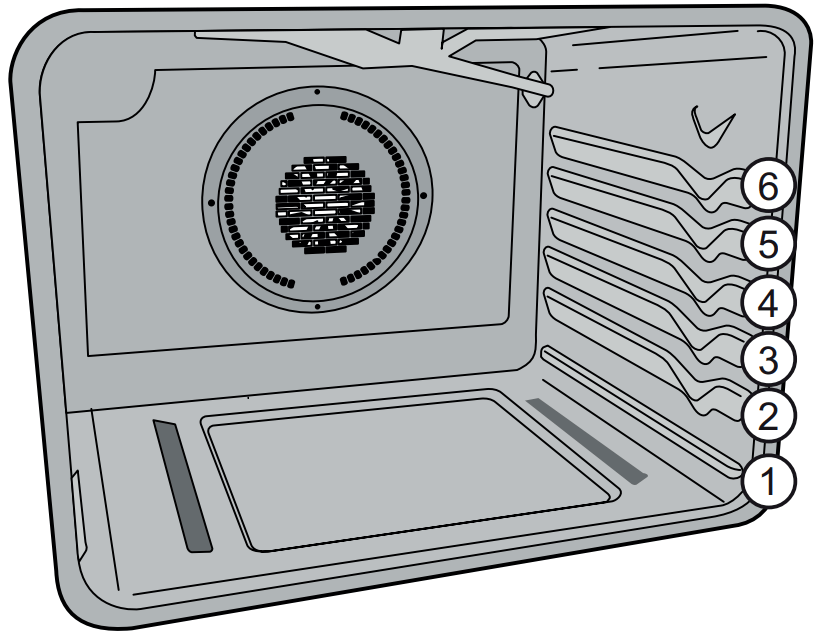
Figure 13: Rack positions
NOTE The broiler pan and the insert (some models) allow grease to drain and be kept away from the high heat of the broiler. Do not use the pan without the insert. Do not cover the insert with aluminum foil; the exposed grease could ignite. To purchase a broiling pan and insert, visit frigidaire.com
To set broil:
- Arrange the oven rack while oven is still cool.
- Press broil. The display will show — —.
- Press
 for HI broil or
for HI broil or  for LO broil. Most foods may be broiled at the HI broil setting. Select the LO broil setting to avoid excess browning or drying of foods that should be cooked to the well-done stage.
for LO broil. Most foods may be broiled at the HI broil setting. Select the LO broil setting to avoid excess browning or drying of foods that should be cooked to the well-done stage. - For optimum results, preheat broil for 2 to 5 minutes before adding food.
- If using a broil pan and insert, place insert on the broil pan. Place food on the insert
- Place the broiler pan and insert on the oven rack.
- Broil on one side until food is browned. Turn and broil food on second side.
- When broiling is finished press OFF
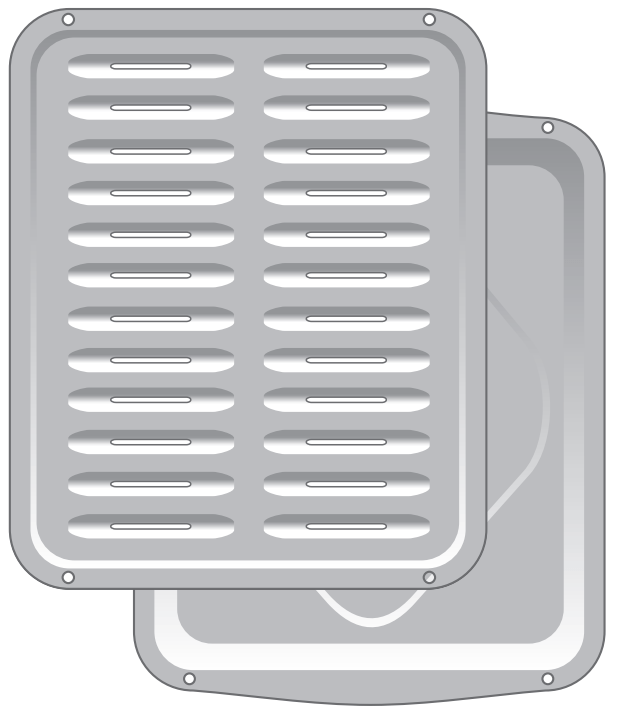
Figure 14: Broil pan and insert
Table 3: Broil recommendations
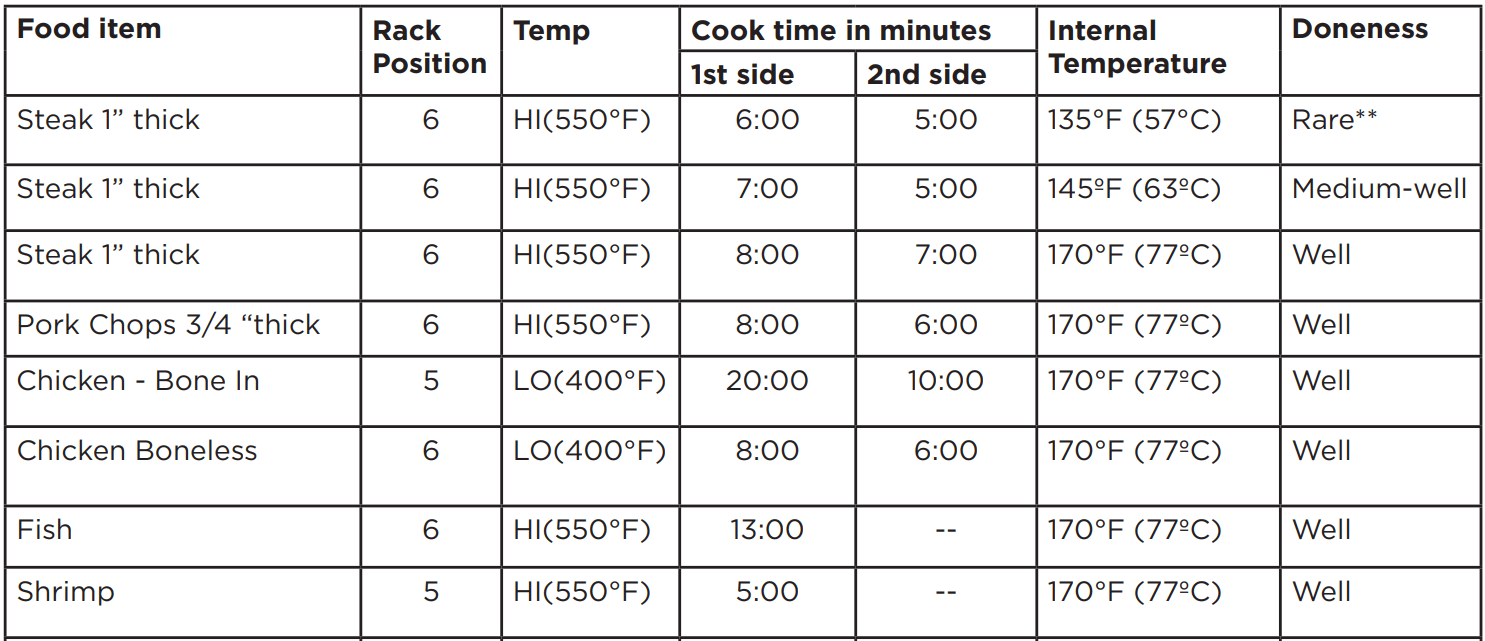

Setting Bake Time
The Bake Time key sets the amount of time needed for baking. The oven will turn on immediately and stop automatically after the set bake time ends.
To program the oven to begin baking immediately and to shut off automatically (timed bake):
- Be sure the clock is set to the correct time of day.
- Place the food in the oven.
- Press Bake. — — — ° appears in the display.
- Within 5 seconds, press
 or
or  . The display will show 350°F (177°C). The temperature can then be adjusted in 5°F (1°C) increments,
. The display will show 350°F (177°C). The temperature can then be adjusted in 5°F (1°C) increments, - Press Bake Time. 0:00 will appear in the display.
- Press
 or
or  until the desired baking time appears in the display.
until the desired baking time appears in the display. - The oven will turn on and begin heating.
When the set bake time runs out:
End will appear in the display, and the oven will shut off automatically.
The control will beep three times every 60 seconds as a reminder until OFF is pressed.
NOTE
- Bake Time will not operate when using the broil feature.
- Once the controls are set, the oven will come on and begin heating to the selected baking temperature. The oven temperature (or time of day) will show in the display.
Adjusting the oven temperature
Your appliance has been factory calibrated and tested to ensure an accurate baking temperature. For the first few uses, follow your recipe times and temperature recommendations carefully. If you think the oven is cooking too hot or too cool for your recipe times, you can adjust the control so the oven cooks hotter or cooler than the temperature displayed.
CAUTION
- Do not use oven thermometers such as those found in grocery stores to check the temperature settings inside your oven. These oven thermometers may vary as much as 20 to 40 degrees from actual temperatures.
- Oven temperature adjustments made will not affect the broil or self cleaning feature temperatures.
- If the display is set for Celsius, adjustments made will be in 1°C increments with each press of arrow keys
To adjust oven temperature:
- Press Bake.
- Set the temperature to 550°F (288°C) by pressing and holding

- Within 3 seconds, press and hold Bake until numeric digit(s) appear. Release Bake key. The display now indicates the amount of degrees offset between the original factory temperature setting and the current temperature setting. If the oven control has the original factory calibration, the display will read 00.
- The temperature can now be adjusted up +35°F (+19 °C), in 5°F increments. Press and hold
 to adjust the temperature higher until the desired amount of offset appears in the display. When lowering the oven temperature using
to adjust the temperature higher until the desired amount of offset appears in the display. When lowering the oven temperature using  key.
key. - When you have made the desired adjustment, press OFF to go back to the time of day display
Self Clean
A self cleaning oven cleans itself with high temperatures (well above normal cooking temperatures), which eliminate soils com- pletely or reduces them to a fine powdered ash you can wipe away afterwards with a damp cloth.
While the oven is in operation, the oven heats to temperature much higher than those used in normal cooking. Sounds of metal expansion and contraction are normal. Oder is also normal because the food soil is being removed. Smoke may appear through the oven vent.
CAUTION
During the self cleaning cycle, the outside of the range can become very hot to the touch. Do not leave small children unattended near the appliance.
The health of some birds is extremely sensitive to fumes given off during the self clean cycle of any range. Move birds to a well ventilated room.
Do not force the oven door open. This can damage the automatic door locking system. Use caution when opening the door after the self cleaning cycle is complete. The oven may still be VERY HOT.
Do not line the oven walls, racks, bottom, or any other part of the range with aluminum foil. Doing so will destroy heat distribution, produce poor baking results, and cause permanent damage to the oven interior (aluminum foil will melt to the interior surface of the oven).
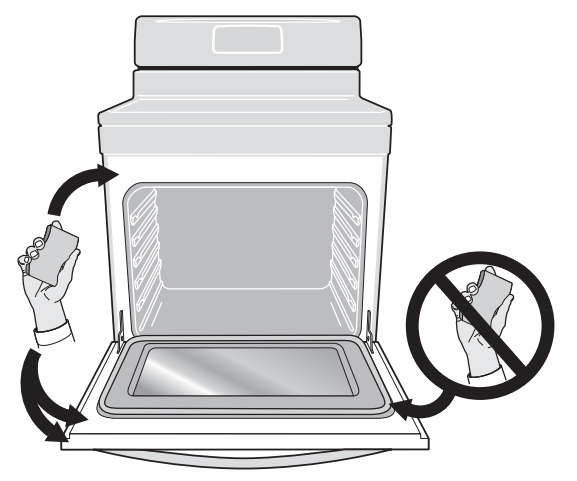
Figure 17: Door Gasket
IMPORTANT
- Do not use oven cleaners or oven protective coatings in or around any part of the oven interior.
- Do not clean the oven door gasket (Figure 17). The woven material of the oven door gasket is essential for a good seal. Care should be taken not to rub, damage, or remove the gasket.
- Do not use any cleaning materials on the oven door gasket. Doing so could cause damage.
- Remove the broiler pan and insert, all utensils, and ANY ALUMINUM FOIL. These items cannot withstand high cleaning temperatures and will melt.
- Completely remove ALL OVEN RACKS and ANY ACCESSORIES. If the oven racks are not removed, they will lose their special coating properties and no longer slide in and out of the oven cavity easily.
- Remove any excessive spills. Any spills on the oven bottom should be wiped-up and removed before starting the self cleaning cycle. To clean, use hot, soapy water and a cloth. Large spills can cause heavy smoke or fire when subjected to high temperatures.
- Do not allow food spills with a high sugar or acid content (such as milk, tomatoes, sauerkraut, fruit juices, or pie filling) to remain on the surface as they may leave a dull spot even after cleaning.
- Clean any soil from the oven frame, the door liner outside the oven door gasket, and the small area at the front center of the oven bottom. These areas heat sufficiently to burn soil on. Clean with soap and water. These areas are shown in white.
To set a self clean cycle
- Press Self Clean. --- appears in the display.
- Press
 until 3:00 appears in the display for a 3 hour self clean process, or push
until 3:00 appears in the display for a 3 hour self clean process, or push  until appears in the display for a 2 hour self clean process.
until appears in the display for a 2 hour self clean process. - As soon as the controls are set, the motor driven lock will begin to close automatically and the door locked indicator light will flash. Do not open the oven door while the light is flashing allow about 15 seconds for the oven door to lock).
- CLn will appear in the display during the self clean cycle, and the door locked light will glow until the self cleaning cycle is complete or cancelled and the oven temperature has cooled.
When the self clean cycle has completed:
- The time of day will appear in the display window, and the Self Clean indicator light and Door Locked light will continue to glow.
- Once the oven has cooled down for about 1 hour and the Door Locked light has gone out, the oven door may be opened.
- To avoid possible burns, use care when opening the oven door after the self cleaning cycle. Stand to the side of the oven when opening the door to allow hot air or steam to escape.
To stop or interrupt a self clean cycle (once it has been activated):
- Press OFF.
- Once the oven has cooled down for about 1 hour and the door locked light has turned off, the oven door can be opened.
- Restart the self clean cycle once all conditions have been corrected.
NOTE
Whenever the self clean feature is active, you may check the amount of time remaining in the self clean cycle by pressing the clean key. Remember the range door cannot be opened until the range has cooled sufficiently. You will need to add about 1 hour to the time displayed before you can use the range for cooking.
When the oven is cool, wipe away any residue or powdered ash with a damp cloth or paper towel.
Steam Clean
The Steam Clean feature offers a chemical free and time saving method to assist in the routine cleaning of small and light soils.
CAUTION
- Do not add bleach, ammonia, oven cleaner, or any other abrasive household cleaners to the water used for Steam Clean.
- Before cleaning any part of the oven, be sure all controls are turned off and the oven is cool. The oven may be hot and can cause burns.
Be sure the oven is level and cool before starting
Steam Clean. If the oven temperature is above room temperature a triple beep will be heard and the function will not start. Steam Clean produces best results when started with a cool oven.
To set a Steam Clean cycle:
- Remove all racks and oven accessories.
- Scrape or wipe loose debris and grease from the oven bottom.
- Pour 1 cup of tap water onto the oven bottom. (Figure 19) Close oven door.
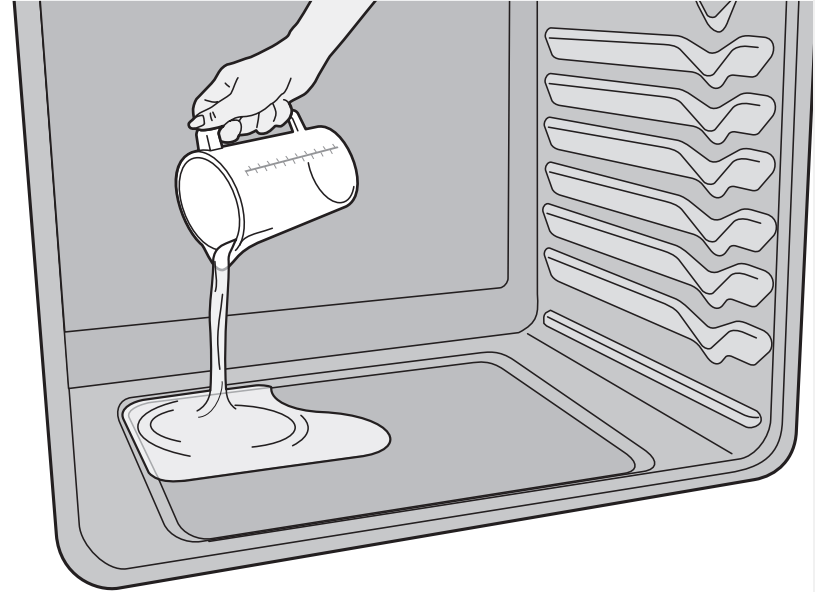
Figure 18: Add 1 cup of tap watter to bottom of oven
4. Press steam clean.
5. Press  or
or  . to activate. St Cn will appear in the display.
. to activate. St Cn will appear in the display.
6. The oven will start automatically and the display will show the time remaining in the Steam Clean cycle. Do not open the door during this time. If door is open while in steam clean (d-O) will appear in the display.
7. When the steam clean cycle is complete an alert will sound and the END message will show in the display. Press OFF to return to the clock. Press OFF at any time to cancel the Steam Clean.
8. Take care opening the door when the steam clean is finished. Stand to the side of the oven out of the way of escaping vapor.
9. Wipe oven cavity and bottom. Do not clean oven door gasket (Figure 18). Avoid leaning or resting on the oven door glass while cleaning cavity

Figure 19: Clean around the oven door gasket
NOTE
- Opening the oven door during the steam clean cycle prevents the water from reaching the temperature needed to clean.
- For best results, clean oven immediately after the cycle is complete. Steam clean works best for soils on the oven bottom.
- A non-abrasive scouring pad, stainless steel sponge, plastic scraper, or eraser style cleaning pad (without cleaner) can be used for difficult soils. Moisten pads with water before use.
- Place a paper towel or cloth in front of the oven to capture any water that may spill while wiping out.
- Do not leave the residual water in the oven for any length of time.
- Some condensation or water vapor may appear close to the oven vent and the oven door glass.
- This is normal. The oven gasket may become damp; do not wipe dry.
- Local water sources often contain minerals hard water). If hard water deposits occur, wipe cavity with a 50/50 solution of water and vinegar or 50/50 solution of lemon juice and water.
CARE & CLEANING
Remove spills and any heavy soiling as soon as possible.
Regular cleaning will reduce the difficulty of major cleaning later.
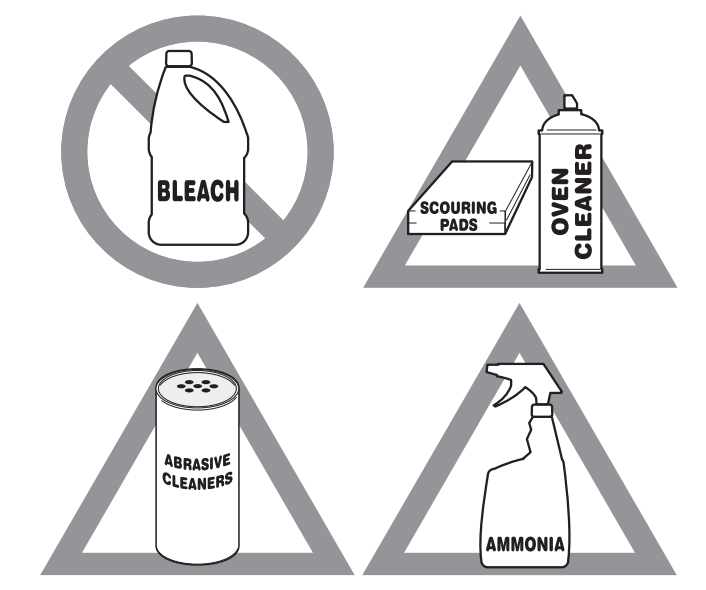
Figure 20: Use cleaners with caution
CAUTION
- Before cleaning any part of the appliance, be sure all controls are turned off and the appliance is cool.
- If ammonia or appliance cleaners are used, they must be removed and the appliance must be thoroughly rinsed before operating. Follow manufacturer's instructions and provide adequate ventilation.
| Surface or Areae | Cleaning Recommendation |
|---|---|
| Aluminum and vinyl | Using a soft cloth, clean with mild dish detergent and water. Rinse with clean water, dry and polish with a soft, clean cloth. |
Painted and plastic control knobs Painted body parts Painted decorative trims | Using a soft cloth, clean with mild dish detergent and water or a 50/50 solution of vinegar and water. Rinse with clean water, dry and polish with a soft, clean cloth. Glass cleaners may be used, but do not apply directly to surface; spray onto cloth and wipe. |
| Control panel | Using a soft cloth, clean with mild dish detergent and water or a 50/50 solution of vinegar and water. Do not spray liquids directly on the oven control and display area. Do not use large amounts of water on the control panel - excess water on the control area may cause damage to the appliance. Do not use other liquid cleaners, abrasive cleaners, scouring pads, or paper towels - they will damage the finish. |
| Control knobs | Using a soft cloth, clean with mild dish detergent and water or a 50/50 solution of vinegar and water. To remove control knobs: turn to the OFF position, grasp firmly, and pull off the shaft. To replace knobs after cleaning, line up the OFF markings and push the knobs into place. |
| Stainless Steel | Using a soft cloth, clean with mild dish detergent and water or a 50/50 solution of vinegar and water. Rinse with clean water, dry with a soft clean cloth. Do not use cleaners containing abrasives, chlorides, chlorine, or ammonia. |
Smudge Proof™ Stainless Steel Black Stainless Steel | Using a soft cloth, clean with mild dish detergent and water or a 50/50 solution of vinegar and water. Rinse with clean water, dry with a soft clean cloth. Do not use appliance cleaner, stainless steel cleaner, or cleaner containing abrasives, chlorides, chlorine, or ammonia. These cleaners may damage the finish. |
Porcelain-enameled broiler pan and insert Porcelain door liner Porcelain body parts | Rinse with clean water and a damp cloth. Scrub gently with a soapy, non-abrasive scouring pad to remove most spots. Rinse with a 50/50 solution of clean water and ammonia. If necessary, cover difficult spots with an ammonia-soaked paper towel for 30 to 40 minutes. Rinse and wipe dry with a clean cloth. Remove all cleaners or future heating could damage the porcelain. Do not allow food spills with a high sugar or acid content (milk, tomatoes, sauerkraut, fruit juices or pie filling) to remain on porcelain surfaces. These spills may cause a dull spot even after cleaning. |
| Manual clean oven interior | The oven interior is porcelain coated and safe to clean using oven cleaners. Always follow manufacturer's instructions for cleaners. After cleaning, remove any oven cleaner or the porcelain may become damaged during future heating. Do not spray oven cleaner on any electrical controls or switches. Do not spray or allow oven cleaner to build up on the oven temperature sensing probe. Do not spray cleaner on oven door trim, door gasket, plastic drawer glides, handles or any exterior surfaces of the appliance. |
| Self-cleaning oven interior | Before setting a self-clean cycle, clean soils from the oven frame, areas outside the oven door gasket, and the small area at the front center of the oven bottom. “Self Clean” |
| Oven door | Use mild dish detergent and water or a 50/50 solution of vinegar and water to clean the top, sides, and front of the oven door. Rinse well. Glass cleaner may be used on the outside glass of the door. Ceramic smoothtop cleaner or polish may be used on the interior door glass. Do not immerse the door in water. Do not spray or allow water or cleaners to enter the door vents. Do not use oven cleaners, cleaning powders, or any harsh abrasive cleaning materials on the outside of the oven door. Do not clean the oven door gasket. The oven door gasket is made of a woven material which is essential for a good seal. Do not rub, damage, or remove this gasket |
| Gas cooktop surface burners | See “When replacing the burner caps, be sure the burner caps are seated firmly on top of the burner heads.” |
Gas cooktop surface grates Gas cooktop burner caps | Use a non-abrasive plastic scrubbing pad and mild abrasive cleanser. Do not allow food spills with a high sugar or acid content (milk, tomatoes, sauerkraut, fruit juices or pie filling) to remain on the burner grates or burner caps. These spills may cause a dull spot even after cleaning. Clean these spills as soon as surfaces are cool. Thoroughly dry immediately following cleaning. |
Cleaning the sealed burners
To avoid possible burns, do not attempt cleaning before turning off all surface burners and allowing them to cool.
Any additions, changes, or conversions required in order for this appliance to satisfactorily meet the application needs must be made by an authorized qualified Agency. Routinely clean the cooktop. Wipe with a clean, damp cloth and wipe dry to avoid scratches. Keeping the surface burner head ports and slots clean will prevent improper ignition and an uneven flame.
To clean recessed and contoured areas of cooktop:
- If a spill occurs on or in the recessed or contoured areas, blot up spill with an absorbent cloth.
- Rinse with a clean, damp cloth and wipe dry.
To clean burner heads:
1. Remove the burner cap from the burner head (see Figure 21). Clean the cap with hot soapy water and dry thoroughly.

Figure 21: Burner Cap
2. For burned-on and dried spills, apply hot soapy water to the burner head. Allow time for the soils to soften.
3. Use a toothbrush to clean all over the burner head (see Figure 22).
4. Use the toothbrush to clean the slots and holes in the burner.
5. Use a needle or fine wire to clean out the ignition port
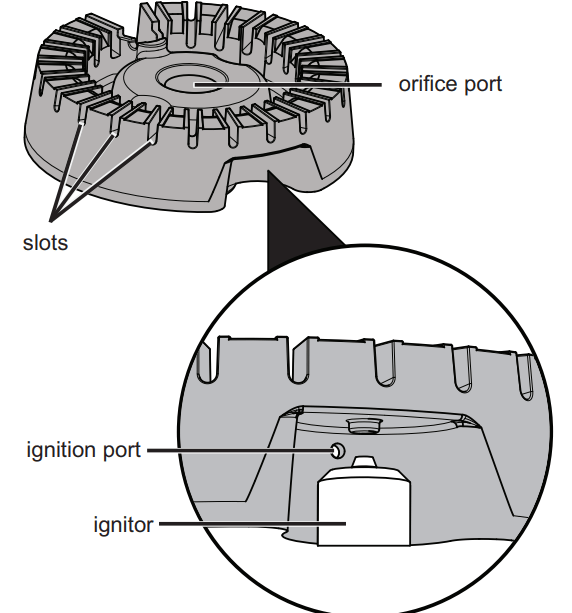
Figure 22: Cooktop cleaning
Replacing Oven Light
Replacing the oven interior light bulb:
The interior oven light is located at the rear of the oven cavity and covered with a glass shield. The glass shield must be in place whenever the oven is in use (Figure 23).
- Turn electrical power off at the main source or unplug the appliance.
- Remove the interior oven light shield after removing the wire holder by carefully moving the wire to the side of the glass shield. The tension from the wire holds the glass shield in place.
- Pull the shield straight out. Do not twist or turn.
- Replace the bulb with a new appliance bulb.
- Replace the glass oven light shield. Replace wire holder.
- Turn the power back on again at the main source (or plug the appliance back in).
- Be sure to reset the time of day on the clock.
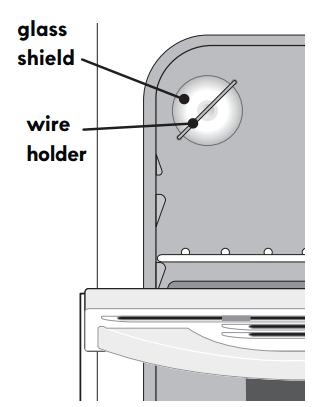
Figure 23: Oven light protected by glass shield
Remove and replace storage drawer
Use the storage drawer for storing cooking utensils. The drawer can be removed to facilitate cleaning under the range. Use care when handling the drawer
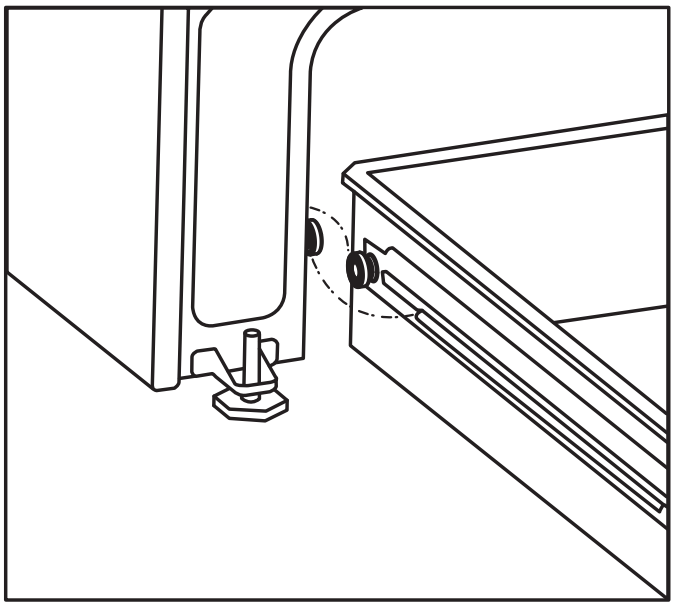
Figure 24: Open storage drawer

Figure 25: Closed storage drawer
Removing and Replacing the Oven Door
CAUTIONTo avoid possible injury when removing or replacing the oven door, follow the instructions below carefully and always hold the oven door with both hands positioned away from the door hinge area.
The door is heavy. For safe, temporary storage, lay the door flat with the inside of the door facing down.
To remove the oven door:
1. Open oven door completely (horizontal with floor -
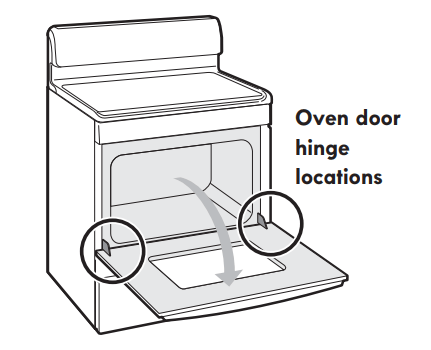
Figure 26: Door hinge location
2. Pull the door hinge locks on both left and right door hinges down from the oven frame completely towards the oven door (Figure 27). A tool such as a small flat-blade screw- driver may be required.
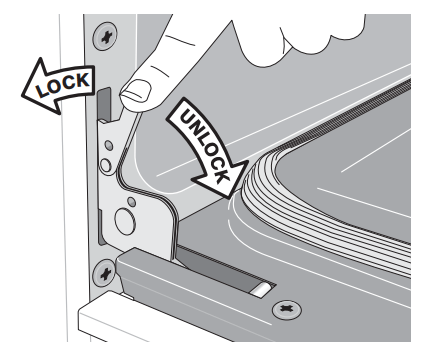
Figure 27: Door hinge Locks
3. Firmly grasp both sides of oven door along the door sides (See Figure 28).

Figure 28: Holding door for removal
4. Close the door to the stop position (the oven door will stop into this position just before fully closing). (See Figure 28).
5. With the oven door in the stop position, lift the oven door hinge arms over the roller pins located on each side of the oven frame (See Figure 29).
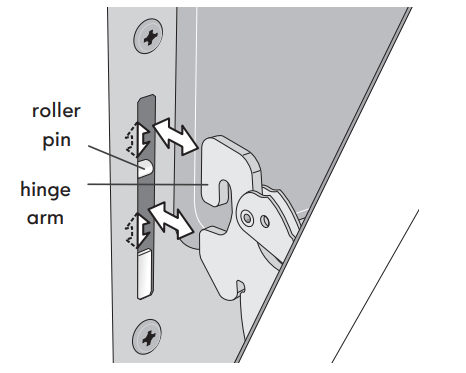
Figure 29: Replacement and location of hinge arm and roller pin
To replace oven door:
- Firmly grasp both sides of oven door along the door sides. Do not use the oven door handle (See Figure 28).
- Holding the oven door at the same angle as the removal position, seat the hook of the hinge arm over the roller pins located on each side of the oven door frame (See Figure 29). The hook of the hinge arms must be fully seated onto the roller pins.
- Fully open the oven door, horizontal with floor (See Figure 26).
- Push the door hinge locks up towards and into the oven frame on both left and right oven door hinges to the locked position (See Figure 27).
- Close the oven door.
IMPORTANT Special door care instructions - Most oven doors contain glass that can break. Do not hit the glass with pots, pans, or any other object. Scratching, hitting, jarring, or stressing the glass may weaken its structure, causing an increased risk of breakage at a later time. Do not close the oven door until all of the oven racks are fully in place.
TROUBLESHOOTING
Oven Baking
| Baking Problems | Causes | Corrections |
|---|---|---|
Cookies and biscuits burn on the bottom.
| Cookies and biscuits put into oven before oven is preheated. |
|
Cakes too dark on top or bottom
|
|
|
Cakes not done in center
|
|
|
Cakes not level.
|
|
|
Foods not done when cooking time is over.
|
|
|
Before you call
| Problem | Solution |
|---|---|
| Entire appliance does not operate. |
|
| Oven Problems | |
| Poor baking results | Many factors affect baking results. Make sure the proper oven rack position is used. Center food in the oven and space pans to allow air to circulate. Allow the oven to preheat to the set temperature before placing food in the oven. Try adjusting the recipe's recommended temperature or baking time. |
| Flames inside oven or smoking from oven vent. | Excessive spillovers in oven. For example, this will happen for pie spillovers or large amounts of grease left on the oven bottom. Wipe up excessive spillovers before starting oven. |
| Oven smokes excessively when broiling. |
|
| Oven control panel beeps and displays any F or E code error. | Oven control has detected a fault or error condition. To clear the error, press the OFF key on the control panel. Once the error code is cleared, try the bake or broil function. If the F or E code error repeats, turn off the power to appliance, wait 5 minutes, and then repower the appliance. Set the clock with correct time of day. Try the bake or broil function again. If the fault recurs, press the OFF key to clear. |
| Oven portion of appliance does not operate. |
|
| Convection fan does not rotate. |
|
| Cooktop Problems | |
| Surface burners do not ignite. |
|
| Surface burner flame uneven or only part way around burner cap. |
|
| Surface burner flame is too high. |
|
| Surface burner flame is orange. |
|
| Self-Clean Problem | |
| Self Clean does not work. |
|
| Oven racks discolored or do not slide easily. |
|
| Soil not completely removed after Self Clean. |
|
| Other Problems | |
| Appliance is not level. |
|
| Cannot move appliance easily. Appliance must be accessible for service. |
|
| Oven light does not work. | Be sure the oven light is secure in the socket. See “Replacing the Oven Light”. |
See other models: FFHS2622MQ FGHS2369KE FFHT1621QW GLEF389HS FFHP222WQ2
